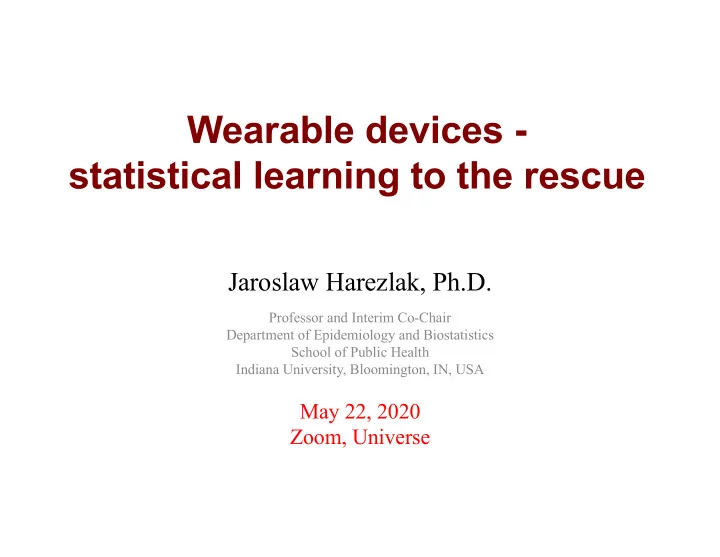

Wearable devices - statistical learning to the rescue Jaroslaw Harezlak, Ph.D. Professor and Interim Co-Chair Department of Epidemiology and Biostatistics School of Public Health Indiana University, Bloomington, IN, USA May 22, 2020 Zoom, Universe
Outline Wearable and implantable devices • Overview of the accelerometry data • Micro-scale analysis • Detection and analysis of walking • Gait features • Macro-scale analysis
Accelerometry data in health research: challenges and opportunities Review and examples Statistics in Biosciences, 1-28, 2019 Authors: Marta Karas Jiawei Bai Marcin Str ą czkiewicz Jaroslaw Harezlak Nancy Glynn Tamara Harris Vadim Zipunnikov Ciprian Crainiceanu Jacek Urbanek
Wearable and Implantable Technology • Wearable and implantable devices are smart electronic devices (electronic device with micro- controllers) that can be worn on the body as implants or accessories • Emerging technology • Growing popularity in health research
Actigraphy • Actigraphy: non-invasive monitoring of activity • Accelerometer records human movement
Other wearable/implantable devices
Major data challenges • Data size • Complexity and heterogeneity • Lack of standardized data collection protocols – Device type – Device location – Wear/non-wear – No. of days of observations
Collaboration Biostatisticians and data scientists Epidemiologists Health Research Software engineers Clinicians
Raw accelerometry data els annel 3 chan 60s*3 z*60s 50Hz* 50H = ers 9000 number 9000 2020 1 count 1
Macro- and Micro-scale • Macro-scale – summarized data (1-minute intervals) Macro-scale Features 0.4 0.35 0.3 0.25 CPM VMC [g] 0.2 0.15 0.1 0.05 0 0 5 10 15 20 Hours • Micro-scale – raw accelerometry data (10Hz+)
Micro-scale analysis • Activity type recognition – Detection of walking , driving – Climbing stairs, resting, sedentary vs. upright
Why walking? • Common form of physical activity • Features of walking related to: – Survival – Mild Cognitive Impairment – Dementia – Stroke Urbanek, J, Zipunnikov, V, Harris, T, Crainiceanu, C, Harezlak, J , Glynn, NW, Validation of gait characteristics extracted from raw accelerometry during walking against measures of physical function, mobility, fatigability, and fitness, The Journals of Gerontology: Medical Sciences, 2018 Apr 17;73(5):676- 681
Data heterogeneity
Walking on level ground 𝑦 𝑢 ! + 𝑧 𝑢 ! + 𝑨 𝑢 ! 𝑤𝑛 𝑢 =
Down/up/down stairs
Courtesy of Marta Karas Goal: segment strides from accelerometry walking data Raw subsecond-level Segmentation of Strides Feature extraction of human gait and accelerometry walking data (2 subsequent steps) gait pattern Extract: ● gait speed ● stride-to-stride variability statistics ● subject-specific gait pattern Karas, M., Straczkiewicz, M., Fadel, W ., Harezlak, J., Crainiceanu, M., Urbanek, J., Adaptive empirical pattern transformation (ADEPT) with application to walking stride segmentation, Biostatistics (accepted)
Characteristics of walking Magnitude [g] Cadence [steps/s] Amplitude [g] Time [s] Amplitude [g] Stride phase Urbanek, J, Harezlak, J, Glynn, NW , Harris, T, Crainiceanu, C, Zipunnikov, V, Stride variability measures derived from wrist-and hip-worn accelerometers, Gait & Posture 52 (2017) 217–223 Urbanek, J, Zipunnikov, V, Harris, T, Fadel, W , Glynn, N, Crainiceanu, C, Harezlak J, Prediction of sustained harmonic walking in the free-living environment using raw accelerometry data. Physiological measurement 39 (2), 02NT02
DECOS Study @ University of Pittsburgh P OPULATION : N = 51 (26 WOMEN ) ENROLLED IN THE D EVELOPMENT E PIDEMIOLOGIC C OHORT S TUDY (DECOS) A GE : BETWEEN 70 AND 90 ( MEDIAN = 78, SD = 5.68), BMI: BETWEEN 20.5 AND 37.9 ( MEDIAN 25.9, SD = 3.91) D ATA : F REE - LIVING DATA COLLECTED FOR 7 DAYS LEFT AND RIGHT WRISTS : A CTI G RAPH GT3X+ (80 HZ ) HIP : A CTI G RAPH GT3X+ (80 HZ ) THIGH : ACTIV PAL 3 (20 HZ ) TREATED AS SILVER STANDARD
Sedentary vs. upright
Sitting/Standing Results Left wrist Right wrist Method SedUp SS SedUp SS Window [s] 15 30 45 60 75 90 - 15 30 45 60 75 90 - TPR Median 0.79 0.81 0.83 0.83 0.84 0.83 0.66 0.82 0.83 0.84 0.85 0.86 0.86 0.65 TNR Median 0.90 0.90 0.91 0.91 0.91 0.91 0.85 0.91 0.92 0.92 0.93 0.93 0.93 0.88 MAPE [%] 13.3 13.0 12.7 12.6 12.6 12.5 18.2 15.7 15.3 15.2 15.0 15.1 15.1 19.5 MPE [%] 4.1 4.5 3.7 3.4 3.5 2.9 4.1 5.3 4.6 5.6 4.3 4.5 4.5 6.7
Results (left wrist)
Micro-scale analysis Summary • Objective quantification of physical activity • Objective measures of physical performance, fatigability, mobility and fitness (free-living) • Algorithm development • Statistical learning methods
Macro-scale analysis • Aggregated 1-minute intervals • General questions
• US nationally representative sample • Physical activity data for ~12 000 participants • 7 consecutive days of observation • ~10,000 observations per subject • Variety of clinical and demographic outcomes • Linked mortality data • Publicly available dataset • Big data challenges
Counts-per-minute PA data
Macro-scale challenges • Data format, storage and structure • Start times of monitoring periods • Different number of days across subjects • Missing data due to non-wear • Quality control
Data processing pipeline Aggregated Quality N x D x 1440+ Activity Flags Activity Data Data Get Total No. Create of Days of Non-wear flags Observation Exclusion criteria + Get Start Dates N x D x 1440+ Demographics and Times Non-wear flags Create N x D x 1440+ Subset the data Data Structure N x D x 1440+ Clean Statistical analysis Activity Data activity data
Macro-scale: summary • Curating data is extremely time intensive • Proposed pipeline: – efficient analysis of PA data – fast complex analysis – applied to data from NHANES and BLSA
Acknowledgements University of Wroclaw • Michal Kos (Statistics) Johns Hopkins School of Medicine • Jacek Urbanek (Biostatistics) • Marta Karas (PhD student) • Ciprian Crainiceanu (Biostatistics) • Vadim Zipunnikov (Biostatistics) Indiana University • William Fadel (Biostatistics) Harvard University • Marcin Straczkiewicz (Biostatistics) University of Pittsburgh • Nancy Glynn (Epidemiology)
Thank you
Recommend
More recommend